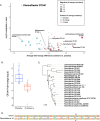Limited effects of long-term daily cranberry consumption on the gut microbiome in a placebo-controlled study of women with recurrent urinary tract infections
- PMID: 33596852
- PMCID: PMC7890861
- DOI: 10.1186/s12866-021-02106-4
Limited effects of long-term daily cranberry consumption on the gut microbiome in a placebo-controlled study of women with recurrent urinary tract infections
Abstract
Background: Urinary tract infections (UTIs) affect 15 million women each year in the United States, with > 20% experiencing frequent recurrent UTIs. A recent placebo-controlled clinical trial found a 39% reduction in UTI symptoms among recurrent UTI sufferers who consumed a daily cranberry beverage for 24 weeks. Using metagenomic sequencing of stool from a subset of these trial participants, we assessed the impact of cranberry consumption on the gut microbiota, a reservoir for UTI-causing pathogens such as Escherichia coli, which causes > 80% of UTIs.
Results: The overall taxonomic composition, community diversity, carriage of functional pathways and gene families, and relative abundances of the vast majority of observed bacterial taxa, including E. coli, were not changed significantly by cranberry consumption. However, one unnamed Flavonifractor species (OTU41), which represented ≤1% of the overall metagenome, was significantly less abundant in cranberry consumers compared to placebo at trial completion. Given Flavonifractor's association with negative human health effects, we sought to determine OTU41 characteristic genes that may explain its differential abundance and/or relationship to key host functions. Using comparative genomic and metagenomic techniques, we identified genes in OTU41 related to transport and metabolism of various compounds, including tryptophan and cobalamin, which have been shown to play roles in host-microbe interactions.
Conclusion: While our results indicated that cranberry juice consumption had little impact on global measures of the microbiome, we found one unnamed Flavonifractor species differed significantly between study arms. This suggests further studies are needed to assess the role of cranberry consumption and Flavonifractor in health and wellbeing in the context of recurrent UTI.
Trial registration: Clinical trial registration number: ClinicalTrials.gov NCT01776021 .
Keywords: Cranberry; Flavonifractor; Metagenome; Microbiome; Urinary tract infection (UTI).
Conflict of interest statement
KLK and CK are employees of Ocean Spray (Lakeville-Middleboro, MA). All other authors have no competing interests to declare.
Figures



References
-
- Gupta K, Hooton TM, Naber KG, Wullt B, Colgan R, Miller LG, Moran GJ, Nicolle LE, Raz R, Schaeffer AJ, Soper DE, Infectious Diseases Society of America, European Society for Microbiology and Infectious Diseases International clinical practice guidelines for the treatment of acute uncomplicated cystitis and pyelonephritis in women: a 2010 update by the Infectious Diseases Society of America and the European Society for Microbiology and Infectious Diseases. Clin Infect Dis. 2011;52:e103–e120. doi: 10.1093/cid/ciq257. - DOI - PubMed
Publication types
MeSH terms
Substances
Associated data
Grants and funding
LinkOut - more resources
Full Text Sources
Other Literature Sources
Medical

